Imagine: according to the approved project plan, preparations for a regular event went on and on - and then r-times! - when there were only a few weeks left until the hour X, everything turned sharply by 180 degrees.
I became very curious, who is there, behind the scenes of this stage, and who is waving the baton over the crowd of participants? How does all this work in Veeam? How did they manage to move the speeding train to other tracks so quickly? And what came of all this?
They revealed the secrets of preparation and shared insiders:
- About the concept, speakers and content - Rick Vanover , Head of Product Strategy
- About preparation and participation in the new interactive - Veeamathon - Denis Churaev , team lead of the technical support team
- About what is “under the hood” (platform, mechanics, statistics) - Vladislav Matushev , Head of Marketing Events Department
So, welcome backstage at VeeamON 2020.
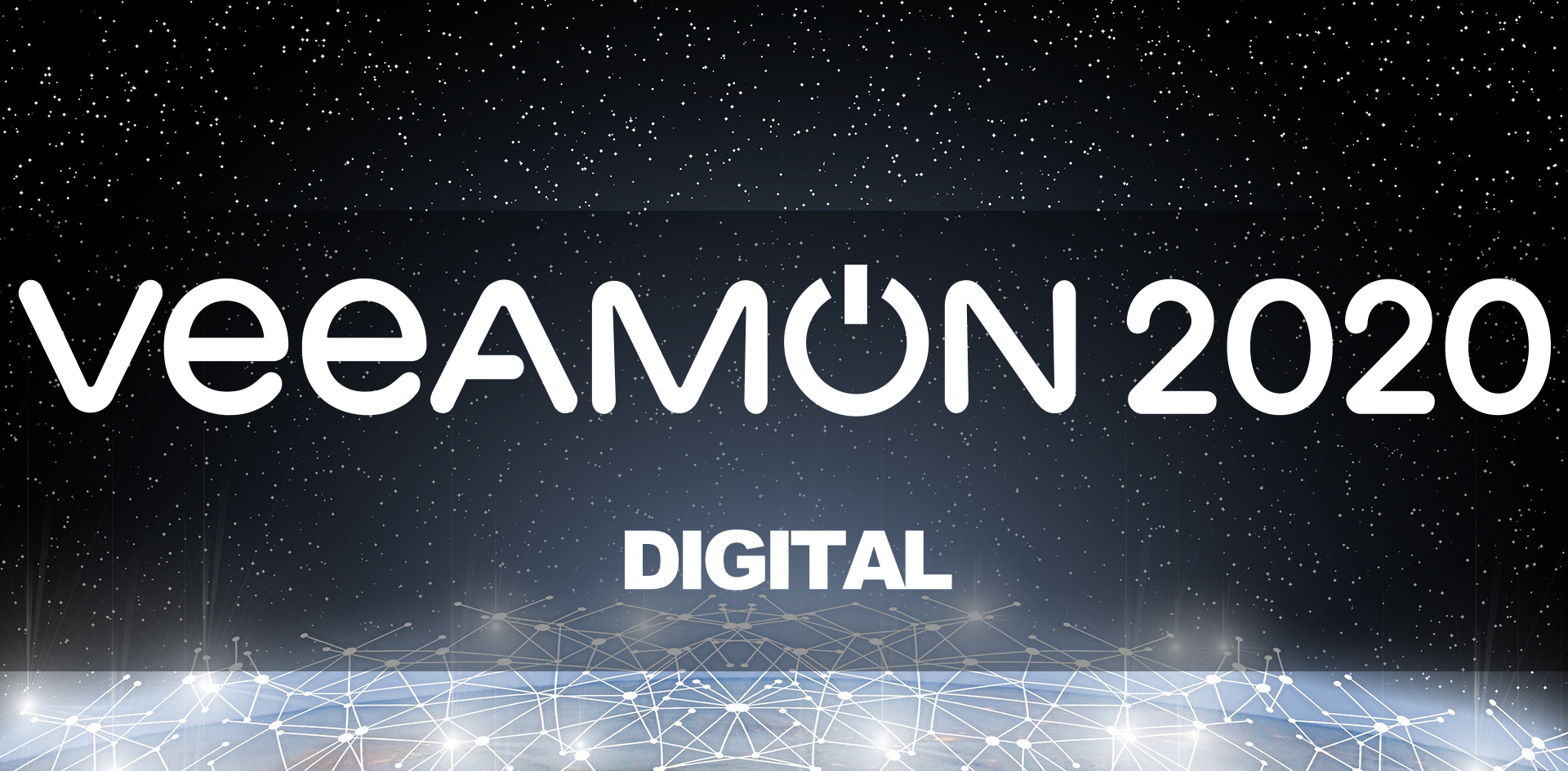
Let's start from the stove: for those who don't know yet - what is VeeamON?
Rick: This is an annual global IT conference that Veeam Software hosts for its existing and potential customers, distributors, partners, and technology alliances. On VeeamON, you can learn about the company's performance over the past year, get the latest information about upcoming releases first-hand, improve your skills in working with Veeam solutions, and much more.
The first conference was held in 2014 in Las Vegas , then again Vegas , New Orleans, Chicago and Miami. In 2020, VeeamON was supposed to return to Las Vegas. But the world has changed, and the organizers of VeeamON and other similar events have had to comply by moving them to the online format.
The conference was held for 2 days, each one began with a review speech: on the first day it was a business session with the participation of top management, on the second - a more technical presentation on new features, new versions and new solutions of Veeam. Then there were thematic sessions. Each time slot contained 3 technical speeches and one on a business topic. Yes, yes, this time there was much more technical content - we analyzed the experience of previous conferences and gave more time to speakers on technical topics.
We also paid great attention to our sponsors and partners, the entire “ecosystem” of our distributors, resellers and service providers. We helped all of them to adapt to the new format: each of them had a virtual information desk, some of them acted as speakers.
There were also live demos from our systems engineers and architects.
Some of the performances were broadcast live, some were recorded. All this was divided into 4 streams according to global time zones to reach the audience in different regions. The listener could choose to watch 4 sessions, and the rest could be viewed in the recording on the conference website. The entire program of events and materials is available at veeamon.com .
In addition, this year we have prepared Veeamathon- completely new content by technical support engineers: 10 live performances with a story (and demonstration), how to diagnose and fine-tune Veeam products and solve various interesting problems.
All materials were available during the event - it was possible to download reports in presentation format or pdf-document. Recordings of speeches are uploaded to the library, which will be available to all registered during the year (until the next conference).
On the second day, there was always a cool party, the participants of which remembered it then for a whole year, until the next VeeamON. And VeeamON 2020 was no exception - it culminated in a free online concert by renowned performer Keith Urban.
"Do you have a plan, Mr. Fix?"
When did you start preparing for such a large-scale event? How much in advance?
Vladislav: Traditionally, VeeamON was planned for the first days of May, and since the beginning of the year full preparation has already been going on, as is done for physical events. It starts a year earlier, and even earlier: selection of a site, selection of a contractor, development of sponsorship packages.
But then it happened the way it happened, and we all realized in late March-early April that something was going wrong with this world, and we might have to adapt, and very quickly. We made the decision to transfer the event (and all events) to the online format within a few weeks or months after we realized that this is such a global trend and there is no getting away from it.
It took about 2 months to prepare the first online VeeamON, and this is a record figure. And European events (6 "copies" of American VeeamON) were prepared in a month! If I had been told six months ago that an event of such a scale should be done in such a period, I would say that it is unrealistic.
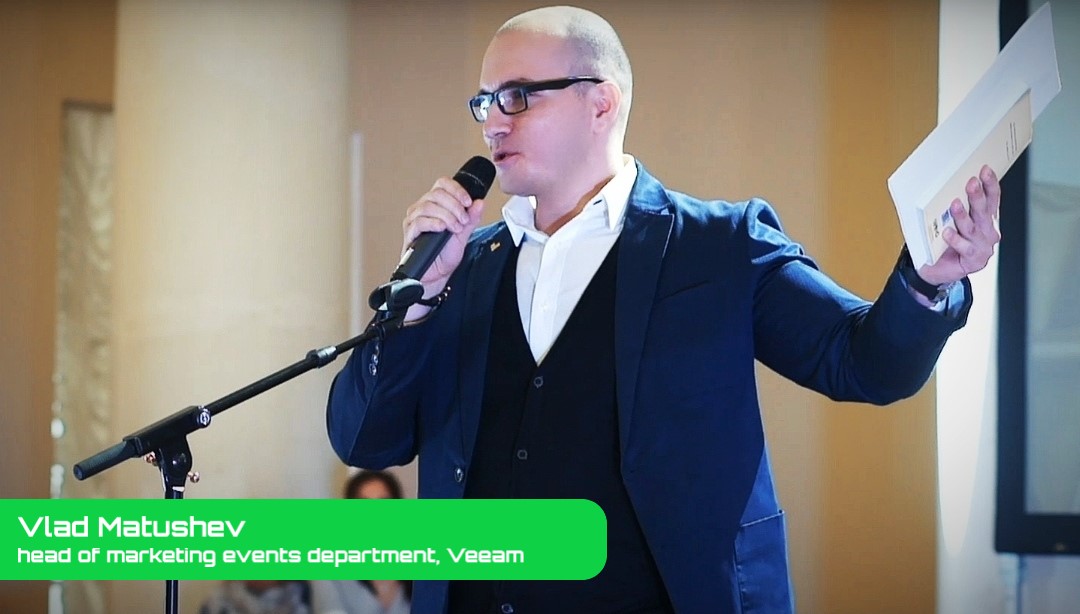
But nevertheless, we stepped up, we connected all the teams, all the resources to the maximum, retrained those who were involved in conferences and exhibitions in the usual format - we quickly repurposed them to prepare online events. This was also a challenge for those people who were doing it for the first time: people with great expertise, who, perhaps, worked in the event industry for 10 years, and here, in the format of a new hire [new employee], to work on an online event ... This, on the one hand, it's a challenge, but on the other, it's very interesting.
Rick:In April, it became clear that the conference would have to be held online. We were already preparing the content with might and main, and by that time quite a lot of people had already registered for the event. Some speakers were alarmed and asked questions, since many conferences were canceled altogether. The virtual conference was our plan B, but it turned out that it became plan A (and, I note, everything went even better than we expected).
Statistical figures report on 150 countries where the participants were from - this, of course, is a colossal coverage. Registration, as I understand it, was first announced for an offline conference, and then I had to switch to online. How did this affect the registration of listeners?
Vladislav:It has increased significantly! Because people who register on VeeamON should understand that they will have to spend money on tickets, on a hotel, to fly to Las Vegas - even if a person is in America, he will still have to spend money on it. Nevertheless, we have more and more participants at physical events from year to year. And when our clients and partners realized that this might be the first and last opportunity to join the event from anywhere not only in the USA, but throughout the planet, registrations began to grow and exceeded our most optimistic expectations.
Rick:With the transition to Plan B, it was decided that participation would be free. Everyone who has already purchased tickets received a refund. And after we announced our transition to online, the number of registrations increased incredibly: in the end, we had more than 28,000 registered members from 148 countries! And that's not counting those who signed up later to watch the materials. At the same time, people came really interested: more than 6,000 people were with us for as long as 6 hours - and this is only at the reports, and what can we say about the online concert of Kiit Urban!
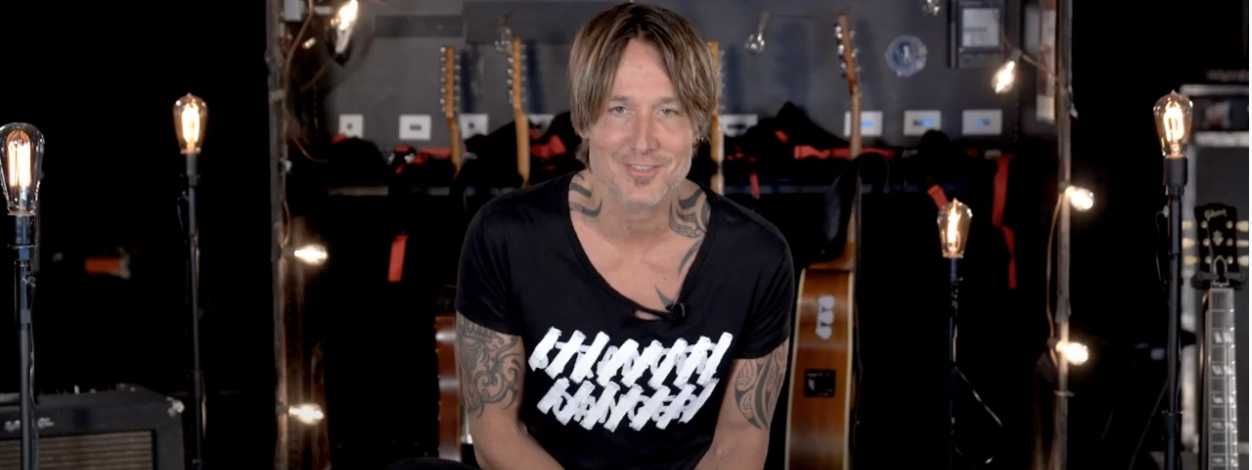
"First of all - planes"
What technical support was required?
Rick: We needed very good cameras and the highest quality video. Most platforms like Zoom, GoToMeeting, etc. optimized for direct delivery of content, and for our requests such systems were not very suitable. After all, we had to not only stream, but also ensure the storage of materials throughout the year. So to speak, “data availability in action” :). We were looking for a platform that could provide this scalability without any constraints. During the speech, the engineers had to not only demonstrate the solution of non-trivial problems, but also answer questions on the air. The platform interface made it possible on the listener's side to customize the window panes in a convenient way, unload presentation slides, and ask questions.
Denis:The web interface was quite convenient. What was also nice was that in a week they made a full demo of the platform for us and even held a test conference so that every specialist was convinced that everything was in order. In addition, the platform itself provides a support specialist. If something went wrong, it was possible to communicate directly with a specialist in a special chat so that he could help. But everything went smoothly enough.
The only thing was that someone had problems with the Internet - but not from those who presented, but from those who watched. (I suppose, now everyone is very active on the Internet from home, so this was expected.) But in percentage terms, there were very few complaints, so in principle the platform showed itself. I don’t know if we will use it next year, because, again, I have nothing to do with those who decide.
Vladislav: This was the platform that we used at VeeamON Virtual last year, and that time everything worked out pretty well, the event was interesting, successful, with a large number of participants. And this year it was a logical decision to go [work] with the same platform - because it is always convenient to work with a vendor who already knows the customer, understands certain important nuances, and has an idea of what we want.
Therefore, we decided to conclude a contract with one contractor for all 7 events - 6 European and one global VeeamON. But that the contractor, as it turned out, took on the burden that he could not handle - there was not enough staff and time, because in addition to the global one, they took up the organization of 6 of our European events, working from the time zone of the central part of the United States, as well as for organizing a whole series of online events for other customers ... And in the end it turned out that we had to do a lot on our backend to make the events take place (and, surprisingly, they were successful). I will not go into details, but for the future we will look at what other vendors there are.
"School of life is a school of captains"
Vladislav: From the point of view of launching the event and project management, it was those who were involved in physical events that immediately joined in here: event teams, the field marketing team. We just plugged in and started working. Yes, without much experience with this [format], not really relying on the contractor, but believing that everything will work out, that everything will be fine. I had to plunge into the question myself. But as a result, we went through such a school! Probably, not every university gives such an education in 4 years, as we had to get it in 2 months. And these people can safely go tomorrow or the day after tomorrow and start, for example, a show on CNN. Because everyone has already understood what video formats are, how streaming works, what are the nuances with this whole story.
That is, it was mainly a team of physical events, and all marketing was actively supported: someone was responsible for working on the "virtual booth", someone was responsible for live questions during the sessions. Sales teams were also involved to answer questions from participants on the day of the event - and there were a lot of these questions.
In terms of products, all of the product marketing and Product Strategy team were involved in content preparation. Here, from their point of view, little has changed compared to the way they prepare it for any physical event - there is no need to change anything online.
Rick:I always try to bring something radically new, and not just copy last year's event by “re-wallpapering”. I'm trying to do something that is unlike anyone else. Because conference participants are attracted by the uniqueness: content that you can't get anywhere else, practical experience that you can get only here. In addition, you yourself understand that this year everyone who held such events had to adapt to new realities. We, of course, had to put in a lot of effort. This also applied to content - after all, when we made the very first VeeamON, there were not many products in the Veeam line, but now there are many more! And it was necessary to tell about everyone in the allotted time. As for the speakers, every year we invite well-known speakers whom the public already knows, and certainly some new speakers.
Planning was like putting together a jigsaw puzzle of hundreds of pieces: I had to distribute 75 talks, balancing business presentations with technical topics. Evenly interspersed with presentations and performances that included live demos. At the same time, it was also necessary to help speakers representing partner companies adapt to the new format of the event. Also, take into account the time: we planned the conference taking into account the time zones in the United States (US West, US East), Central Europe - CET (Central European) and Singapore so that people from all over the world could connect. That is, we got a continuous stream of broadcasting for broadcasting in each of these zones.
In general, the formation of such a flexible and comprehensive agenda in all its richness and diversity was not easy for me, I lost my last hair.

As a result, we got 20 sessions, some of the content was recorded in advance, and the broadcast itself went on for 2 days in 3 regions: America, Europe, Asia and Oceania. Each listener was provided with the opportunity to listen to 4 reports during the session: 3 technical and 1 business presentation. And you could choose the topic of interesting technical reports - they were devoted to various products: Veeam Backup & Replication, Agents, Office 365. Plus, we had reports, including live demos - they were presented by our system engineers and architects.
Anyone who has registered for the conference or wants to see the materials from it will have free access to all reports during the year.
It is really very convenient. After all, people, for example, from New Zealand, from the Philippines or from the CIS countries, could not always fly to an offline conference. And here everyone had the opportunity to see what interests him in their region. Moreover, it was convenient for both listeners and participants: that is, a speaker from Australia could make his report from home for Canada or for Russia.
Denis: Yes, and [for the speakers] it was done quite competently: each speaker was given a session at a convenient time, and in other time zones it was simply relayed. Accordingly, afterwards we could return to the list of questions and go offline. And people could come later, every other day, and find answers to the questions they asked before.
Moreover, there was an interesting interface: all sessions were "in line", and it was written how many hours and minutes until the next session. And you could press a button to send a letter to Outlook that the session will be coming soon. That is, it was very convenient to schedule your own viewing. In this regard, the interface was very cool. There was such a big schedule that it was very easy to keep track of.
“I liked the stand, questions, prizes”
Who was the “virtual entertainer” this season?
Rick: This time we called the guy who makes these funny videos - his name is Tripp Crosby (but his famous video “ Conference call in real life ”). It was he who was the entertainer, he did all sorts of funny "bundles". Of course, he wrote down the opening speech beforehand, but the rest was pure improvisation.
Have any "chips" of offline events migrated to the online format? Was there live communication?
Vladislav: Yes, there was live communication, not only some sessions (recorded or live), but also the opportunity to ask a question right during the session. And the technical [experts] - systems engineers - were also online throughout the events to answer questions.
There was also a “digital booth” format, a digital “booth” (stand), where you can do approximately the same as on a real physical “booth”, for example, at VMWorld: you can watch some white paper, watch a live demo, ask a question to a technical specialist or marketer, that is, there was an opportunity to chat on the "booth". It turned out to be a complete interaction with the company. The sponsors also had their own "virtual booths".
Plus some exclusive materials available to the visitors of this "booth", and even merchandise.
How did you distribute the merch?
Vladislav:We sent it out. We developed gamification for the event: people collected badges for certain activities. (This is how we pushed them to be more active within the framework of the conference - not just come and listen to the session, but ask questions, fill out a survey, watch a demo.) And the more such activities a person shows, the higher their rating in the virtual scorecard that everyone can see. This is an element of gamification - people like it when they see their name at the top of the leaderboard.
And based on this, we gave out prizes - sent out the merch after the event. There are special services that allow you to deliver it to the addressee.
There was even such an option: on the German VeeamON, the first to come to the event was offered a voucher for pizza delivery. Came first - get pizza, eat and enjoy the event.

Did you develop the mechanics of this gamification yourself or did you use a ready-made one?
Vladislav: Mostly yourself. We had some templates in terms of implementation on this platform. Then we thought: what is especially important for us for the person to do as part of this event? So that we understand that he is interested in our products, and not just a passing "giveaways hunter", as happens at physical events. (Here, of course, this point is leveled: if a person has joined an online conference, he is unlikely to know anything about Veeam and he is not interested in our products.)
Developed our own guidelines and templates for gamification. For example, we created a separate quiz that worked online: you could press a button, and the score counter started, the participant had to temporarily answer questions about Veeam. And the dashboard included the rating of those people who know our products better, etc.
Everything is in the format of an online game, because people are pleased not only to listen to something, but also to play, to compete.
"Content with heat, with heat"
Can you tell us more about the reports?
Rick: That here there is a list of all speakers. On the first day, there was a review session, attended by top managers of Veeam: CEO Bill Largent and Director of Marketing Jim Kruger.
The second day was a cool technical session, which was prepared by Melissa Palmer, Danny Allan (Technology Development Director), Anton Gostev (theRealGostev) and Michael Cade. They presented future releases of Veeam products.
So, for example, in the Veeam Backup for Office 365 solution it is planned to fully support the backup and recovery of Microsoft Teams. Now, when many specialists work in a “remote” mode, when communications in companies go digital, Teams is becoming an increasingly popular solution, and we cannot pass it by.
In version 11 of our flagship product Veeam Backup & Replication , the following new items were announced:
- Continuous Data Protection
- Google Cloud Storage Support
- Working with Archive Tier: Amazon Glacier / Deep Archive and Azure Blob Archive
- Instant Recovery Instant Recovery
- from any backup to Hyper-V
- Supports NAS Backup as File Share
- MSSQL and Oracle Databases support
The Veeam Agents family is expected to expand. And it will be - drum roll - Veeam Agent for macOS !
In addition, literally immediately after the completion of VeeamON, a new version of Veeam Availability Orchestrator was released , supporting integration with NetApp SnapMirror.
Our architects from the Technical Alliances team - Shawn Lieu and Adam Bergh - came up with a highly sought after topic of storage integration: Storage Integrations Deep Dive . He talked about how snapshots are taken taking into account the operation of applications, how CBT data is transmitted, how interaction with a proxy takes place. All this allows you to make backups with minimal risk of impact on production.
Michael Cade and Dmitry Popov (@angrydoc) spoke about the intricacies of work and the depths of the NAS backup architecture. This functionality has been eagerly awaited by users for several years. But when implementing backup scenarios, we must not forget about the “3-2-1” rule. Therefore, colleagues explained in detail how the long-term storage policy in the cloud works, how it is recommended to organize the storage of various files, and how to configure archiving.
Fans of Linux systems could not miss a talk by our wonderful pro Tom Sightler - this time he talked about Linux-based repositories: what are the architecture features, what to look for when preparing for deployment, how fast cloning is implemented, how to improve "virus resistance". I highly recommend viewing.
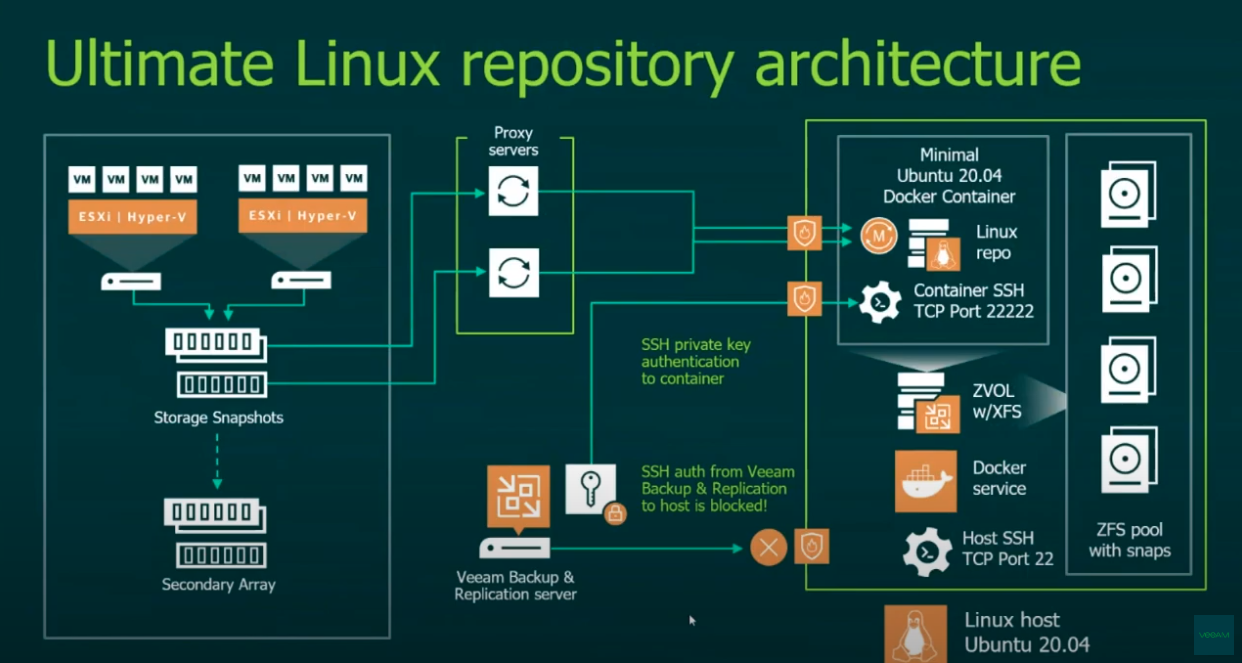
And, of course, everyone's favorite question about resource planning (in numbers and pictures): how to calculate them, and why in life everything is not as it really is? This talk was presented by engineers looking for answers to these questions in a "battlefield" environment: Tim Smith is an architect on the American systems engineering team, previously a member of the Veeam Vanguards project, and Neil Henderson is a senior technical support engineer. Here is a slide from their report, there are also mathematical calculations.
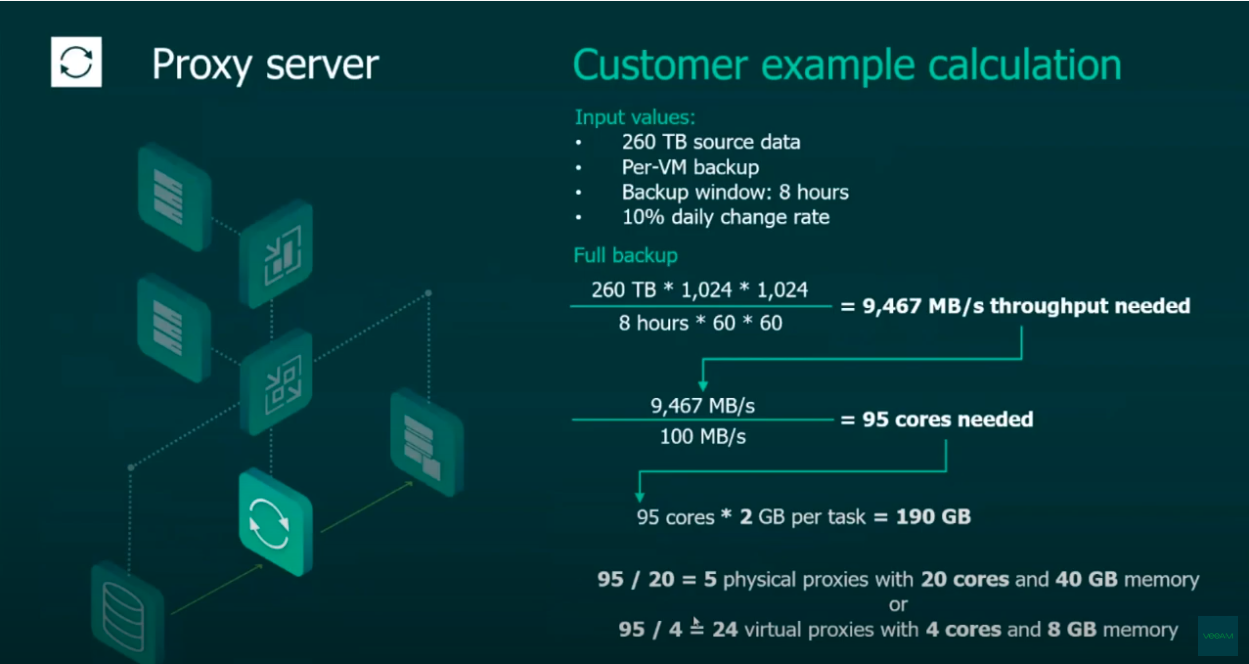
How to view a report that interests you? Go to www.veeam.com/veeamon , register and get free access for almost a whole year (until the next conference).
Marathon? Hackathon? Veeamathon!
I know that in addition to the usual reports, this year there was also a completely new format - this is Veeamathon. What it is?
Denis: Indeed, we have been practicing breakout sessions for a long time, when well-known speakers bring new product features to the public or talk about some interesting details of existing technologies that we use. This is an opportunity for the company to notify customers and interested people about what we can do and what we can do in the future.
In this format, as a rule, system engineers and very famous public speakers were involved - let's say, a certain layer of the company, but it almost did not affect the support. And support is a fairly large department all over the world, in which a lot of people work, and we directly face problems and their solutions.
Karinne Bisset had a new idea - this is our employee from the USA, who organized all this and helped us a lot.

Karinn always comes up with something interesting :)
The idea was to connect the support directly to participation in the conference, creating an additional part related to solving problems (troubleshooting). And we made Veeamathon - this is such a blitz for engineers to demonstrate what else can be done with our product and how cool our guys are. In short, people from the technical support teams were given a certain amount of time to demonstrate their knowledge and skills.
Rick:We originally wanted to do something like a hackathon, but I don’t like the word “hack”, sorry. And so they came up with such a name. Veeamathon is a live session with the support team where people can learn how to configure products and troubleshoot issues with Veeam products.
The preparation team was looking for new formats, we wanted to add more technical content. After all, our users are geeks, they always want more technical information. In principle, our materials are usually designed for different levels of training: beginner, intermediate and advanced. And for the new Veeamathon, it was necessary to prepare 10-12 short scripts specifically for the advanced level, for example, “How to work with virtual disks through the command line”, etc.
We discussed this idea with the support team, which now has several hundred people - about 700. Obviously, they have a lot of technical content on existing products in stock. So he had something to share with the Veeamathon members. For example, there were such topics:
- How to find out what antiviruses are interfering with the normal operation of the backup?
- How do I set up my connection to Microsoft Office 365 for the fastest backup possible?
- How to use custom scripts (pre-freeze and post-thaw) to create consistent backups of Linux applications?
Denis: There were a lot of interesting topics, and it was interesting not only for some technical people, but in general for those guys who came with a not very high level of knowledge - and we tried to convey to them what we can do [with product] so that they can direct their departments towards it. For instance:
- Ability to do something outside the box: it would seem that some functionality is missing in the program, but it can be compensated for in some kind of work-around or in another way
- Creative use of existing functionality: to do something that can be very useful for the company, but no one thought about it - for example, how to restore Teams files, which in theory it is not clear how to back up, but at the same time MS Teams has its roots in SharePoint, in SQL Server, in Exchange. Accordingly, if the components are separately saved to disk and then restored, it is possible, in theory, to get certain information.

Denis begins his performance at Veeamatho n
"Everything in the world was not in vain, it was not in vain!"
How did the participants of the event assess your work? Looking back, what can you say about VeeamON 2020?
Vladislav: From the point of view of the event itself, the format, the final result - of course, this is a tremendous success, I would say. Especially in the current conditions, during a pandemic, when it is generally difficult to imagine how and where to get new clients, how to arrange an event in general, when each vendor "bombards" their databases [clients] with endless webinars, zoom meetings and all sorts of what ideas. Of course, we had a fairly challenging target [high targets for attendance], but when we exceeded it many times, it was, of course, very pleasant.
And the geography is absolutely huge. For example, when a “physical” event is held, then you invite, say, in Germany only those who live in Germany, moreover, only in Munich or Frankfurt or in their vicinity - because others will not go. And here, conducting the German VeeamON in Europe, we invited all people who speak German: from Germany, and from Switzerland, and from Austria, and hundreds of them accepted our invitation with pleasure, that is, this format turned out to be interesting to everyone.
At the same time, despite the fact that we launched 6 local events (in Russian, Spanish, Italian, German, Turkish and French), some people still preferred to go to the big global event. Because this is the scale, it is 2 days of sessions, the content is "hot, hot". It was really interesting and it erased all boundaries.
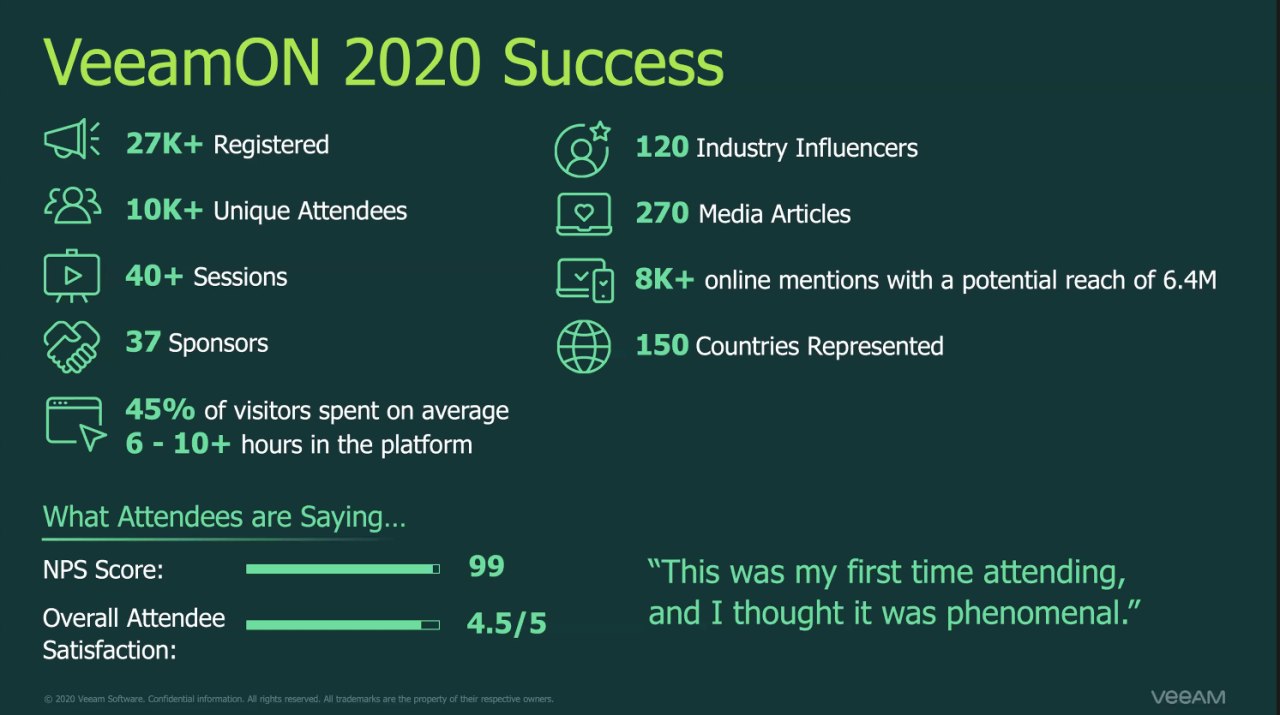
NPS (net promoter score) - 99 points out of 100
Rick: The feedback was very positive! And it was much easier to assemble, this is also a plus.
The online format helped to remove barriers, made the conference accessible to everyone who wanted to participate (both for speakers and listeners). It was possible to participate from any corner of the world. Veeam now has more than 4,000 employees in various countries, we are an international company, and we have the opportunity to invite speakers from different regions. In past years, both speakers and participants were mainly from America (which is explained by the logistics), and in this - from Europe, and from Latin America, and from Australia.
Of course, if I started preparing now, I would definitely have done something differently - for example, more people would have been involved in answering questions.
Denis:The format is very interesting, because there is often a problem in bringing certain people (potential speakers) to a certain place - because this is their time, their work, and the company's money. This is the first thing.
Secondly, there are still some restrictions, for example, there may be a problem with a visa, and so on. And if people have the opportunity to come to the online part, then we will immediately expand the "number of brains", that is, the circle of speakers will greatly expand, the number of interesting topics will increase - and, accordingly, will attract a larger audience.
It turns out such a self-developing, self-improving system.
A full interview with Denis Churaev about how technical support engineers prepared to participate in Vimaton, about life hacks, knowledge and valuable experience - in the next article.
What else to read and see?
Speeches with VeeamON 2020 can be viewed by registering at the link: https://www.veeam.com/veeamon/register
In the registration form, in addition to contact information, in the last field you must indicate whether you are a representative of the client company, partner company and etc. - or just interested in Veeam solutions (in this option, choose Potential Customer ).
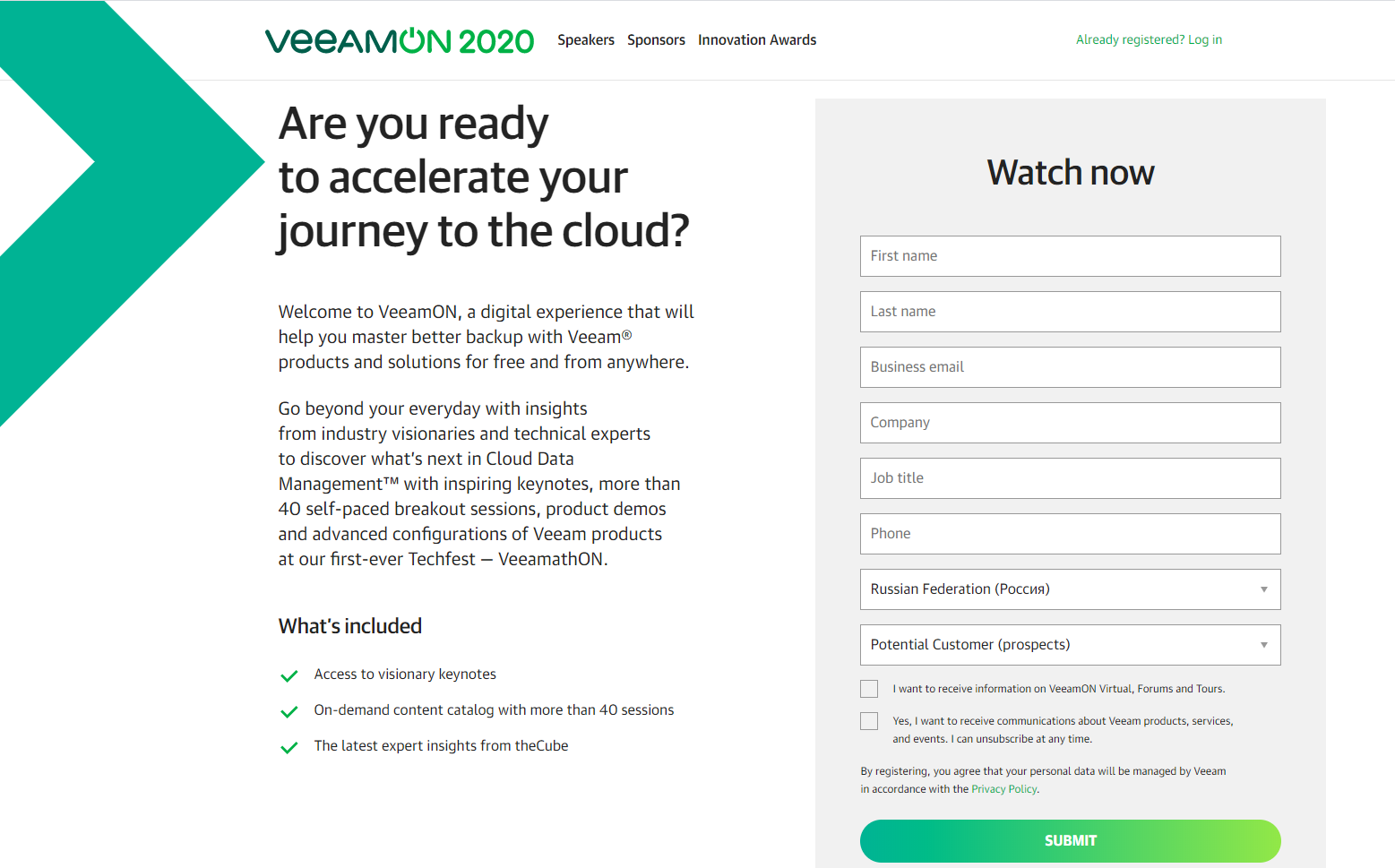
A synopsis featuring Rick Vanover and Veeamathon inventor Karinne Bisset can be viewed here (in English).
Well, by tradition, our blog:
An article on Habré about VeeamON 2019
"On the other side of the stand" - an article on Habré about working at the "booth"